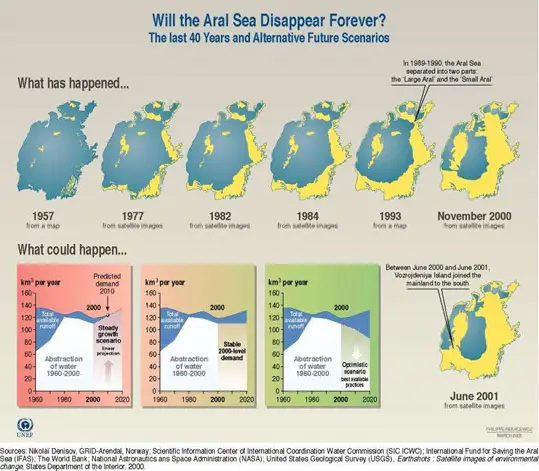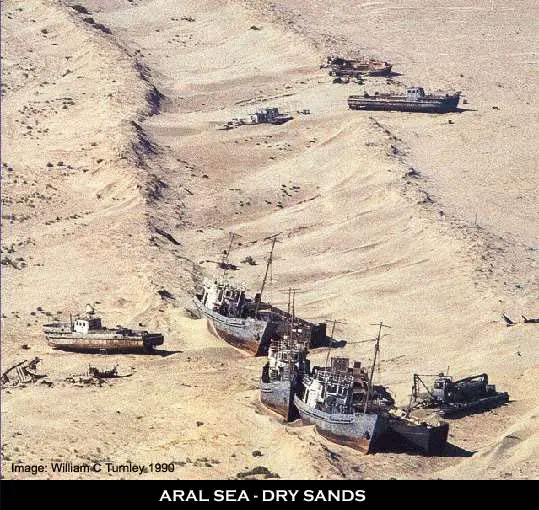Once the world’s fourth largest lake, the mighty Aral Sea is now in it’s death throws. Starved of it’s lifeblood of the waters of the Syr Darya and the Amu Darya rivers, the sea has been shrinking for the last 40 years.
The name “Aral Sea” originates from the word “aral” which means island. The sea’s name reflected the fact that it was a vast lake lying as an island amongst the surrounding waterless deserts. The destruction of the Aral began in Moscow in the 1950s, when Soviet economic planners decided, with the confidence of people wielding absolute power, to order the transformation of Central Asia’s dry lands into the world’s largest cotton belt.
The development of irrigation in the Soviet part of the Aral Sea basin was spectacular: from about 4.5 million hectares in 1960, it rose to almost 7 million in 1980. The population increased from 14 million inhabitants in 1960 to about 27 million inhabitants in 1980. The total water withdrawal through canals increased from 64.7 km³ in 1960 to 120 km³ in 1980, of which more than 90% for agricultural purposes. It resulted in the disruption of the prevailing water balance in the basin and naturally enough, the shoreline began to recede.
It wasn’t just the water for cotton and rice that was draining the inland sea but the irrigation canals themselves were poorly built. This let water leak out or evaporate and from the Qaraqum Canal, the largest in Central Asia, perhaps 30–70% of the water went to waste. The mean sea level dropped 20cm (8″) per year for 10 years, then the drop rate accelerated to 60cm/year in the 70s, then to almost a metre per year in the 80s.

By 1990, as a result of the continuing water diversion and evaporation, the shrinking Aral divided in two and it’s salinity increased from 10 grams per litre to 45. In some parts of the south Aral, salinity tops out at 98 g/litre (2001). Average seawater salinity is 33 g/litre. The once thriving fishing industry employing roughly 60,000 people in the early 1960s has been destroyed along with the fish and most of the flora and fauna. Salt pans and contaminated runoff lakes have appeared, and winters have become harsher and longer, summers hotter and shorter.
In a desperate attempt to keep their vessels in the shrinking Aral, channels were dredged to the open sea. it was a futile exercise, as the sea receded faster than the channels could be built. The fishing industry was effectively gone by 1982, and the canning plant processing frozen fish brought in from other areas to keep fishermen employed, folded in 1991. Of the region’s 73 species of birds, 70 of mammals and 24 of fish, most have either perished or moved on.
An effect of the reduction in the Aral Sea’s size is the exposure of the lake bed. Today, strong winds blow the exposed land picking up and depositing tens of thousands of tons soil every year. This process has not only contributed to significant reduction in breathable air quality for nearby residents, but has also appreciably affected crop yields due to those heavily salt-laden particles falling on arable land.

